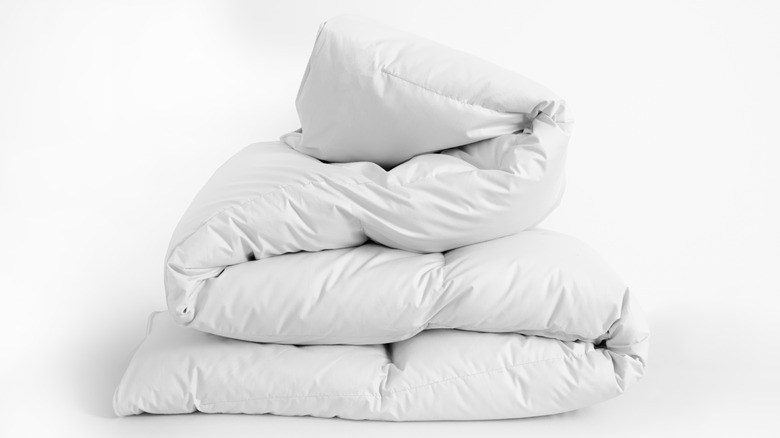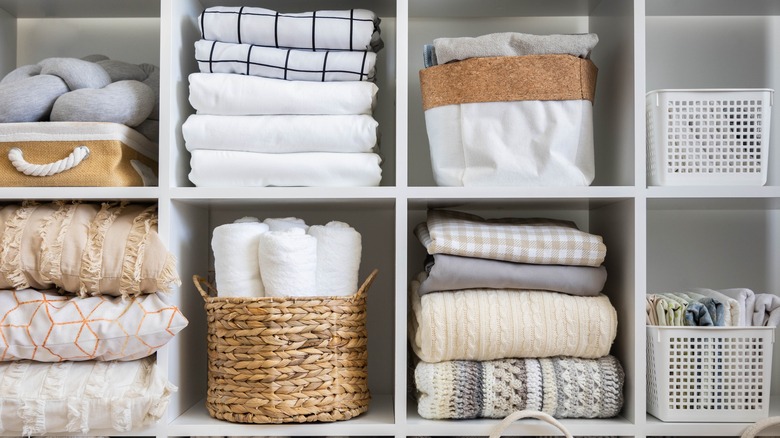Here's How To Store Comforters The Right Way
Proper airflow is a critical factor to consider when it comes to effectively storing comforters, as it helps prevent the buildup of moisture that can lead to that unpleasant, stale musty smell that can sometimes permeate your linens. It plays a pivotal role in preventing the growth of mildew, which can be a common issue if comforters are folded and stored incorrectly. Mildew thrives in damp conditions, and the warm and dark environment created by improperly stored linens provides the perfect breeding ground for these unpleasant bacteria. This is because improper folding can trap moisture within the folds of the comforter, creating an ideal environment for mildew and bacterial growth.
While proper folding techniques are essential, storage also plays a significant role in maintaining the freshness of your comforter. Finding suitable storage solutions might be a bit of a challenge in some residences due to lack of space, but luckily, there are various ways to tuck your comforter away without it occupying too much prime storage real estate.
Start off right with the correct folding method
Proper folding is essential when it comes to storing comforters (or any bulky blankets), as it helps maintain their fluffiness and ensures you're making the most of your storage space. To make folding easier, try doing your comforter origami as soon as your linens are out of the dryer. It makes it easier to fold.
For easier folding, consider folding warm comforters fresh from the dryer, as the warmth makes them more pliable and less prone to wrinkling. For thick comforters, you'll want to fold it into thirds. First, lay it flat on your bed, a clean floor, or a large table, and smooth out to minimize any wrinkles. Fold the comforter across itself from the long side, taking two corners and folding until you reach about two-thirds of the total length, making sure the edges are all lined up. Then, fold the remaining third of the comforter back over the double layer. You should have one long rectangle. Finally, fold the short ends toward the center and fold the entire bundle in half. For thin comforters, fold the comforter by taking one corner and bringing it towards the center, repeating this step for the remaining three corners. Afterward, fold the comforter at its center. You can use a string or ribbon to keep your comforter from unfolding.
Tips for storing your comforter
There are various routes you can take when it comes to keeping your comforters smelling fresh and staying free from allergens. Linen closets offer an ideal storage solution for comforters and bulky blankets. The open shelving means better airflow, which allows your bedding to stay fresh. Remember to leave adequate space between each bedding item to promote airflow and prevent musty odors. If you don't happen to have a linen closet, storing bulky items under your bed is also a practical option. Keep your comforter safe from dust and dander by using fabric bags that are specifically designed for this type of storage and permit proper ventilation, so your comforters stay clean-smelling. Vacuum bags are also a good choice, though your comforter might begin to smell musty after a while. You can prevent this by putting one or two dryer sheets in with the comforter before you seal it shut.
Functional furniture storage options, like footstools, storage benches, and even couches with built-in storage are all good places for comforters. You'll just need to use the correct folding technique so that each of these modular furniture pieces can close completely. If you're lucky enough to have any extra closet space, you can also hang your comforters. This isn't the best option, though, because you'll need to constantly take them outside and bat them to remove any dust.


